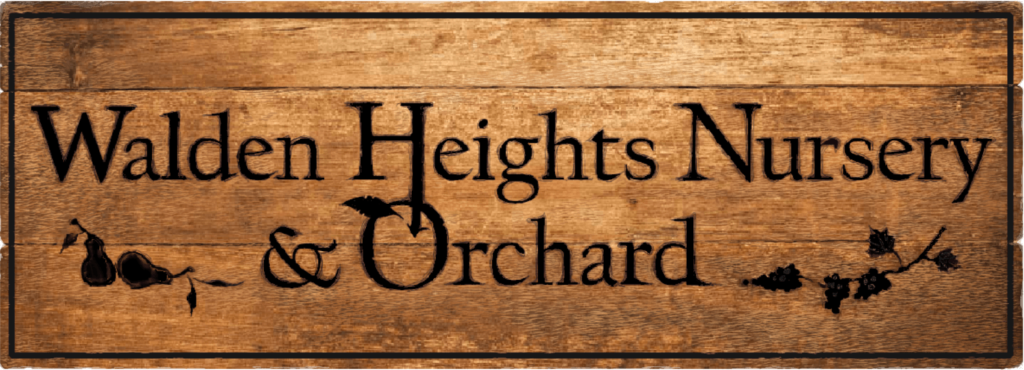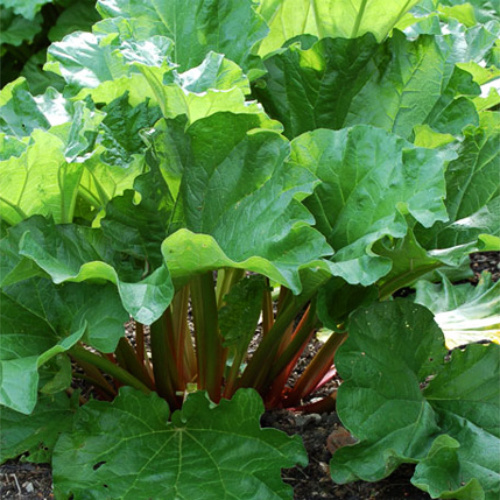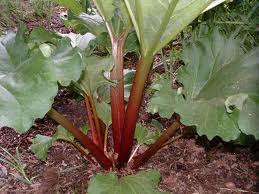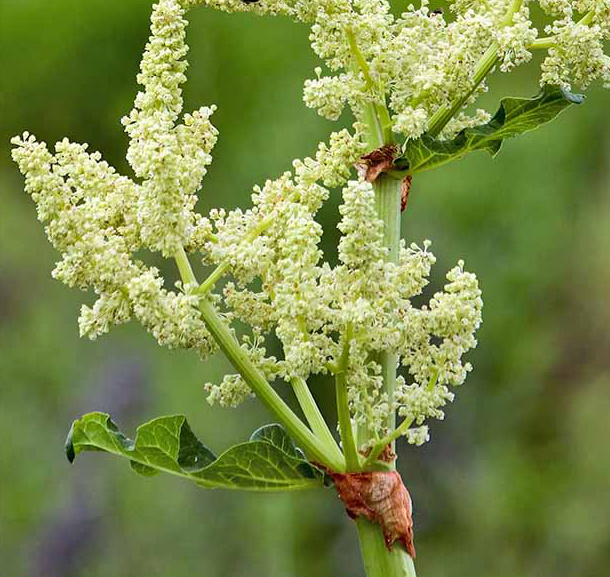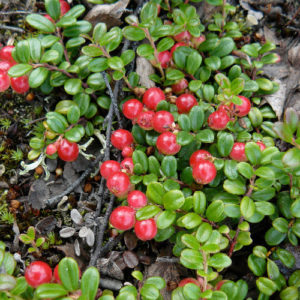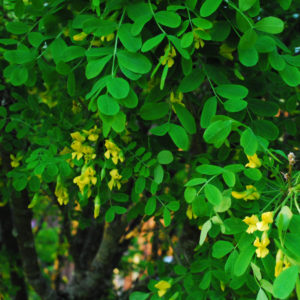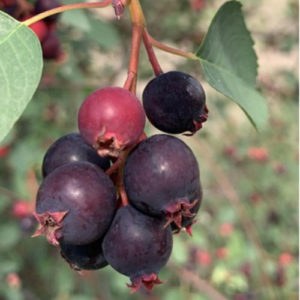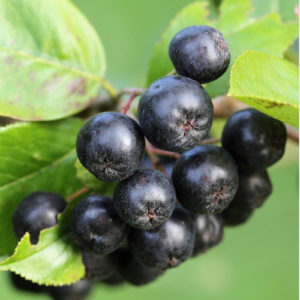Classic green and red stalk producing rhubarb. Bred here at the farm in Walden. Productive and hardy.
Rheum rhabarbarum. Buckwheat family (polygonaceae). Rhubarb began its days of domestication about 2000 years ago in Asia (native to Siberia), beginning first as a medicinal plant and later cultivated as a fresh and culinary one. (Some authors put it in at 5000 years). Known colloquially as the “Pie Plant”.
Growing : Requires 500 hours of chilling (28- 49 degrees F) for the proper formation of new leaf buds. This makes it a better choice for northern climates. Additionally, excess heat will cause the stalks to become softer, stringier and less appetizing. This is a perennial plant, rising either from seed or rhizome transplants, becoming a 2 to 5 foot plant depending on growing conditions. It can tolerate very cold temperatures, and even dry soil conditions. It is however a heavy feeder and will benefit from organic matter, mulches and rich composts. If too much organic matter lies against the plant base, rotting can occur in wet years, so observe the conditions during the season, and remove leaves or debris is circulation is needed. 6.2 to 6.8 is the ideal pH listing for rhubarb, but the plant is quite flexible beyond those recommendations. It is often stated that rhubarb responds well to fertilization with manure, and it does. We do not however think this is wise unless the grower can be sure all pathogens have perished in composting beforehand. The risk from Ecoli is high due to the edible portion of the plant being in such close proximity and the incidence of splashing, etc. When planting, crowns are set about an inch below the soil, after the area had been loosened. Holes 4-6 inches are usually adequate, but a friable surrounding media is better than packed earth. Water well, but if the roots or crown were damaged, a bit of dryness will help it heal better. Set them 2 to 3 feet apart and the rows about 4 feet apart.
The plant comes out of dormancy early, here in Walden poking out of the snow come spring. It will grow vigorously right into summer, with leaves growing sometimes to several feet across. If left to its own devices will produce a flower stem, sometimes 6 feet tall or more, laden with flowers. The seeds resulting betray its family trait, these triangular seeds showing every marking of the familiar buckwheat. It is not necessary to deal with the flower stalk when it appears, but it will consume energy in the plant and often shortens the stalk harvesting window, seeming to make them prematurely hollow and stringy. By this time of year however, we often find the heat of summer has already caused a decline in the “fruit” quality. As an aside, those quotation marks are there, because botanically speaking, rhubarb isn’t a fruit at all but is actually a vegetable since it derives from the non fruiting aerial structure of the plant (think celery). This is the leaf stalk known as a petiole, common to most plants but in this case they are monsters. (Only burdock in the north, and plants in the tropics can compete). The true fruit part of the plant is nestled up top in those “seeds”. In the culinary sense, where most of us reside, it comfortably fits in as a fruit. The stalks can often be harvested for 6-10 weeks.
An added bonus with this plant is that it can be “forced” for consumption in the off-season. After the chilling requirement of 500 hours, temps can be increased to 55-65 degrees to induce growth. By digging crowns and potting them in fall, and allowing to chill, they can be grown in the house, cellar, greenhouse, etc. for a fresh fruit treat for weeks. Who doesn’t want to see green this time of year anyway?
Management : When foliar disease is noticed, it is good practice to remove those parts. We simply harvest those, stalk for consumption and leaf for destruction. Likewise just before winter hits, all diseased portions should be cut out and composted or destroyed. Easiest is to mow the whole plant down and remove it from the growing area, which will not harm the plant. When a patch gets on in years it may be necessary to thin things out.
A word of warning about this plant. Rhubarb leaves should never be eaten, only the leaf stalks. Rhubarb leaves contain large amounts of oxalic acid which are toxic in these amounts. Oxalic acid, H2C2O4, which naturally occurs in leaves of many plants including brassicas like cabbage, and in spinach, potatoes and peas can accumulate and cause kidney stones. The acid also binds with calcium so the body cannot absorb it. Rhubarb leaves contain a potentially lethal amount. Also, there is evidence that the stalks become loaded with oxalic acid following frosts, so allow a few days after frost before harvesting. Likewise, it should not be fed to livestock, with studies showing higher toxicity at lower amounts than would cause illness in humans. Ok, now that we have frightened you, and although a small amount will cause some illness, it would take a 140 pound healthy person eating about 11 pounds of rhubarb for it to be fatal. Keep in mind also that rhubarb is a healthy food, especially since it is one of the only spring fruits available in the north. It is rich in both vitamin C and dietary fiber.
Harvest :
Cut the stalks several days after frost right into summer, being sure to cut off the leaves, and dig in . They can be eaten fresh or in many culinary dishes and juices. One cup of fresh rhubard yields about ¾ cups cooked. It makes a superb wine, one of our favorites. When harvesting, pull and twist the stalk from the plant base. This, instead of cutting will prevent rot from that little stub you will leave behind. Trim the leaves off (we use these big trimmings as a mulch which smothers competing weeds. In the first year, avoid harvesting so the plant can put energy into decent foliar and root growth, you will be rewarded later.
The “fruit” : For those of you who haven’t experienced it, rhubarb is a decidedly sour and crispy stalk. It is much the texture of fresh celery when straight off the plant. It can be eaten then and there through straight out mastication, or can be peeled at bit to reduce its stringiness. Young spring stalks are very much not stringy, this condition occurs as the plant grows during the season. It can be stored for 2-4 weeks at 32 degrees F at 95% humidity. It also freezes well, by cutting or peeling and cutting 1” pieces into bags for easy pie and jam making later in the year, like when the strawberries are ready. The old standby is strawberry rhubarb pie, and ambrosial dish if there ever was one.
Rhubarb Nutritional Information :
Calories 20 Calories from fat 0 % Daily Value* Total Fat 0 g 0% Saturated Fat 0 g 0% Cholesterol 0 mg 0% Sodium 0 mg 0% Total Carbohydrate 4 g 1% Dietary Fiber 2 g 6% Sugars 1 g Protein 1 g Vitamin A 0% Vitamin C 10% Calcium 8% Iron 0% Serving Size : 2/3 cup (85g)
